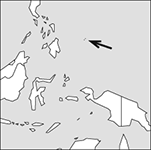
Source: MAPS IN MINUTES™ © RH Publications (1997)
Capital:
Melekeok
Area:
459 sq km (177 sq miles)
Population:
21,108 (2013 est)
Currency:
1 US dollar = 100 cents
Religions:
Roman Catholic 49.4%; Protestant 30.9%; traditional beliefs 8.7%
Ethnic Groups:
Palauan 72.5%; Filipino 16.3%; Chinese 1.6%; Vietnamese 1.6%
Languages:
Palauan, English (both official); Filipino
International Organizations:
UN; Pacific Islands Forum; Secretariat of the Pacific Community
A republic comprising over 200 islands in the western Pacific, only eight of which are inhabited.
Physical
The islands are geographically part of the Caroline Islands. The largest island is Babelthaup. Some of the islands are low-lying coral atolls but others are mountainous. The climate is tropical.
Economy
The main economic activities are fishing, farming, and tourism. Palau depends on aid from the USA.
History
Spain acquired the Caroline Islands in 1886 but sold them to Germany in 1899, having been defeated in the Spanish–American War. Palau was occupied by Japan during World War I and remained under Japanese control until 1944, when it was captured by Allied forces. The islands were administered by the USA as part of the UN Trust Territory of the Pacific from 1947. The islanders voted against becoming part of the Federated States of Micronesia in 1978 and became autonomous in 1981. Palau gained full independence and joined the United Nations in 1994. Under a compact of free association the USA controls the defence of Palau, and has nuclear storage facilities on the islands. Compact grants, which initially lasted until 2009, have been extended to 2024, and now provide around $230 million annually, some of which has gone into a trust fund. This represents over half of government revenue.
- grosbeak
- Grosch’s law
- gross
- gross domestic capital formation
- gross domestic fixed capital formation
- gross domestic product
- gross drying rate
- gross economic potential
- Grosseteste, Robert (c.1168–1253)
- gross fixed investment
- grossing up
- gross investment
- gross lift-off weight
- gross national income
- gross national product
- gross profit
- gross reproduction rate
- gross trading profit
- grossular
- gross value added
- Grothendieck, Alexander (1928–2014)
- Grotius, Hugo (1583–1645)
- Grotrian diagram
- Grotthuss–Draper law
- ground